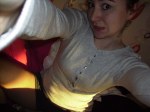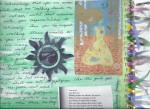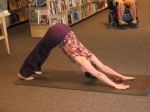 Just in case you aren’t following the fabulous social media expert for writers Kristen Lamb, I’m reposting a brilliant message she put up last week in her also fab course on creating a blog currently in extended session at Who Dares Wins Publishing. I share this because Kristen always hits the nail on the head while the rest of us are noodling around trying to decide which hammer to use. Let me know what you THINK of Kristen’s comments. Take it away Kristen.
Just in case you aren’t following the fabulous social media expert for writers Kristen Lamb, I’m reposting a brilliant message she put up last week in her also fab course on creating a blog currently in extended session at Who Dares Wins Publishing. I share this because Kristen always hits the nail on the head while the rest of us are noodling around trying to decide which hammer to use. Let me know what you THINK of Kristen’s comments. Take it away Kristen.
I have been refraining from posting too many more lessons so that you guys would have time to work on your log-lines-blogs, etc. but this is something that came up this morning and I think it is important to address.
If you haven’t gotten by yesterday’s post, I updated my formula for an author brand.
Name + Great Content + Positive emotions= Author Brand
The positive emotions thing is really important, because I see too many writers posting rants, and I don’t like that at all. It isn’t productive and there is a guarantee that at least some people will walk away feeling like crap. They will feel defensive and under attack. This certainly is not a way to make friends.
A good example
Today, a writer on Twitter posted a nice little rant about “experts.” So, as you can imagine, I checked it out. This writer/blogger probably enjoyed a lot of hits. While I don’t believe she was targeting me
it still felt that way.
Granted, the writer made a lot of excellent points. I have even had some of the same gripes. Any yahoo who opens a Twitter account is now a social media expert and can charge writers for their services. Yes, there are a lot of fakes. BUT, there are also a lot of people who have put in thousands of hours of hard work and who have a genuine intent to serve others.
Yet, the problem with a “rant blog” is it is a rant.
It isn’t a discussion or a debate. It is a bitch session. Nowhere in this blog does the writer ever spell out when a person has earned the right to be called an expert. She doesn’t give any positive examples. Why would she? It’s a rant.
I have seen similar posts blasting publishing, agents, editors, the government, etc. and yes, there are a lot of hits and likely a lot of comments
but at what price?
Rants are divisive. If we are on the attack, then someone else is the attack-ee. Maybe this writer wasn’t targeting me
but it sure felt that way. Why? Well, she never spelled out who fit her definition. Anyone with expert in front of a name was in the blast zone. Maybe it wasn’t me, but her rant was enough to make me waiver a bit and question what I am doing. It made me recount everything I have done and go over my mental resume to see if I really was a fraud after all (All writers already struggle with feeling like a fraud anyway).
Rants hurt others. They only inspire commiseration and misery loves company. People don’t walk away better from a rant. Rants don’t offer answers, because rants, by definition, are complaining, not problem-solving.
This isn’t to say that everything we blog about needs to be candy-coated. Frequently my position as a social media expert puts me at odds with other experts who don’t appreciate that writers are different and that the same tools that sell loads of pizzas won’t sell books. Is it the other experts are wrong? No. Their stuff just doesn’t work for writers. I try to never make it a value judgment. Why burn bridges when we don’t have to?
But that is exactly what rants do
they scorch earth.
I know in my blogs I often give advice that is contrary to other experts, but I always strive to do it in a way that allows the opposition to save face. I am clear who I’m talking about and I give solutions. I employ evidence and reasoning. This is a debate, not a rant.
So the reason I decided to post this is that I noted a definite change in my mood after reading this blog. Negativity has a way of clinging to us like the smell of burned popcorn. The writer’s blog certainly didn’t inspire pink fluffy feelings. But, I always believe there is a lesson to be learned.
I know that as writers we are artists and artists tend to be emotional. But we are now public figures and we must lead transparent lives. This world is small and our profession is brutal. We never know who we might need later, so alienating anyone is poor strategy. Yes, a rant might make us feel good short-term
but people have long memories, especially when they were the ones who felt attacked.
There is an acronym that I think is fabulous for life and for blogging:
THINK
Is it the Truth?
Is it Helpful?
Is it Informative?
Is it Necessary?
Is it Kind?
THINK is a wonderful litmus test for all of our posts. We can be opinionated, controversial, or even thought-provoking
but there is a way to do this that allows everyone to feel good at the end of it all and still be friends
who agree to disagree. Any post that draws firm lines in the sand can spell trouble.
Besides, we all have enough negativity. Doom, gloom, recession, mouthy kids, work, traffic. We are looking for content that makes us feel good, and what is better is that content that makes people feel great? They long to share it
and they can’t wait to return for more.
Many thanks, Kristen.
There are five primary areas of practice to the Writer Wellness plan. Every other week I will post an idea for relaxation (Monday Meditation,) creative play (Tuesday Tickle,) fitness and exercise (Wednesday Workout,) journaling and misc. (Thursday Thought,) and nutrition (Friday Feast.)
 Meanwhile, remember to look for a digital or print copy of Writer Wellness, A Writer’s Path to Health and Creativity at Who Dares Wins Publishing.
Meanwhile, remember to look for a digital or print copy of Writer Wellness, A Writer’s Path to Health and Creativity at Who Dares Wins Publishing.
And check out these great blogs for ideas to keep your writing and publishing healthy and prosperous.
http://writeitforward.wordpress.com/ Bob Mayer
http://jenniholbrooktalty.wordpress.com/ Jenni Holbrook
http://warriorwriters.wordpress.com/ Kristen Lamb
http://inspiration4writers.blogspot.com/ Inspiration for Writers, Inc.
http://pentopublish.blogspot.com/ Natalie Markey
http://amyshojai.com Amy Shojai
And don’t forget my new website Joy E. Held
Have you subscribed to this Writer Wellness blog yet? Get email updates when a new post is added. Click “subscribe” and leave your email. That’s it and thanks in advance!
Be well, write well
 Create is a verb that requires doing. Creativity is a noun that thrives on setting aside moments to think something through. Stillness contributes to the creative process by allowing our minds and bodies to become deeply involved in the steps needed to compose the work. The idea again is to recognize the balance necessary to the creative process. A process usually involves multiple steps in order to achieve the desired outcome. A book, a cake, a painting, a ceramic vase, or a ballet all demand the ordered task of recognizing a question then answering it with creative effort.
Create is a verb that requires doing. Creativity is a noun that thrives on setting aside moments to think something through. Stillness contributes to the creative process by allowing our minds and bodies to become deeply involved in the steps needed to compose the work. The idea again is to recognize the balance necessary to the creative process. A process usually involves multiple steps in order to achieve the desired outcome. A book, a cake, a painting, a ceramic vase, or a ballet all demand the ordered task of recognizing a question then answering it with creative effort. Meanwhile, remember to look for a digital or print copy of Writer Wellness, A Writer’s Path to Health and Creativity at Who Dares Wins Publishing, http://whodareswinspublishing.com.
Meanwhile, remember to look for a digital or print copy of Writer Wellness, A Writer’s Path to Health and Creativity at Who Dares Wins Publishing, http://whodareswinspublishing.com.


 Just in case you aren’t following the fabulous social media expert for writers
Just in case you aren’t following the fabulous social media expert for writers 

 For more information, read Spark, The Revolutionary New Science of Exercise and the Brain by
For more information, read Spark, The Revolutionary New Science of Exercise and the Brain by 
